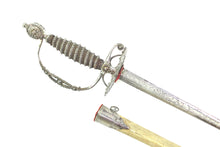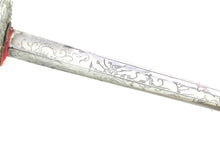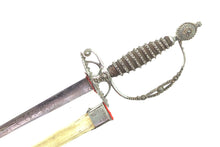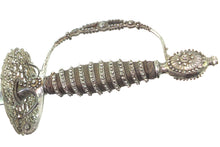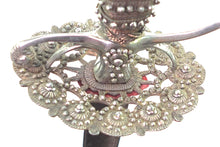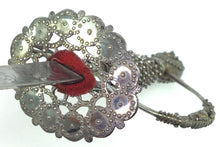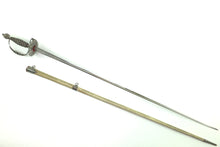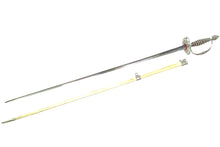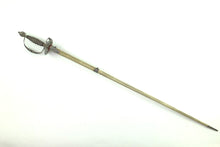
A Very Fine & Rare English Cut Steel Hilt Small Sword made at Woodstock. 39” overall, 33” slender tapering blade of hollow triangular section, etched with scrolls over the forte. Burnished steel hilt comprising pierced petal shaped shell guard centring round a star, a pair of slender pas d' âne, knurled quillon, waisted quillon block, slender knuckle guard with a pierced central moulding & tall ovoid pommel chiselled with a flowerhead front & back. The entire hilt enriched with a profusion of faceted beads in imitation of brilliants and retaining its original grip of plaited copper wire and ribband, the latter decorated en suite with the hilt and retaining much of its original bright polish throughout. In its white vellum covered wooden scabbard with burnished steel mounts comprising locket, chape and middle band, the former two each fitted with a suspension ring.
Circa 1770.
A very rare and fine sword in very good condition, the beads with 4 very small losses, the tip of the blade very slightly bent.
Two similar examples are exhibited in the Metropolitan New York and the Victoria & Albert Museum in London.
The sword's hilt was made in Woodstock near Oxford, Woodstock steel was renowned for its quality. The studs decorating the surface of the hilt are fitted individually and threaded onto the main body. Similar works from Birmingham, including the renowned factory of Matthew Boulton, made rivetted studs that were not removable and of poorer quality. A contemporary diarist, Sylas Neville, wrote, "Steel goods and gloves are the two staples of Woodstock. Their watch-chains and sword hilts are more highly polished and better standard than those of Birmingham. They polish all with hand. Their studs screw, and everything they make can be taken to pieces and cleaned whereas the Birmingham studs are rivetted."
The small Woodstock workshops famed for cut steel jewellery, buckles and Cut-steel small swords were particularly sought after. Sold locally, but also in London its international reputation was spread by fashionable tourists visiting Blenheim Palace. In 1742 Horace Walpole sent Woodstock steel wares to the British Consul in Florence requesting that they be given as diplomatic gifts. In 1759 buckles were ordered for the King of Prussia and in 1768 the King of Denmark,
The design of the present sword perhaps inspired those of Matthew Boulton and James Watt. The former went on to develop mechanised production techniques, including steam powered polishing wheels, that would see the decline of the Woodstock Manufactory. The production of steel goods near Woodstock can be traced back to 1643 with the establishment of a sword mill at nearby Wolvercott. The following century the area became well known for the high quality of its work, Count Frederick Kielmansegge wrote in his diary of 1761-2 that '.....the best steel goods in London come from Woodstock and there is hardly a steelworker who does not employ several workmen'.
Victoria & Albert Museum item number: M.29-1957
Metropolitan NY association number: 26.145.307
The Oxfordshire Museum.
For an account of Woodstock hilts see The Rapier and Small Sword 1480-1820 by Norman 1980, pp 409 - 410.
Dean, Bashford. Catalogue of European Court Swords and Hunting Swords: Including the Ellis, De Dino, Riggs, and Reubell Collections. New York: The Metropolitan Museum of Art, 1929. no. 109, pl. LXXX.
The Metropolitan Museum of Art, Helmut Nickel, Stuart W. Pyhrr, Leonid Tarassuk, and American Federation of Arts. The Art of Chivalry: European Arms and Armor from the Metropolitan Museum of Art: An Exhibition. New York: The Federation, 1982. p, 113, no. 66, ill.
Holcomb, Melanie, ed. Jewelry: The Body Transformed. New York: The Metropolitan Museum of Art, 2018. pp. 140–43, pl. 112.











